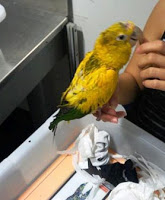| Coiled Snake In Hand |
The first incident occurred at the Miami International Airport (MIA) and involved a gentleman with seven small snakes in his pants. (Insert inappropriate joke here) He also had three small turtles (Insert more jokes here) and they were all stored in lady’s hosiery in the man’s trousers. The snakes and turtles were found using TSA’s imaging technology which allows TSA officers to find potential threat items concealed from plain sight. U.S. Fish and Wildlife officers arrived on the scene and took custody of the reptiles. The passenger was arrested on the federal charge of “harboring reptiles in an unnatural habitat.” I made that up… the individual was actually charged with violating the Lacey Act.
 |
| Freed From The Sock |
TSA’s mission of course is not to find artfully concealed wildlife, but items taped to a passenger’s body could very well be explosives or some other dangerous prohibited item. We just don’t know until we check it out. Threats concealed under a person’s clothes remain a concern and this discovery, threat or no threat, once again demonstrates the effectiveness of TSA’s security techniques.
 |
| Birds Taped In Socks |
If you’d like to comment on an unrelated topic you can do so in our Off Topic Comments post. You can also view our blog post archives or search our blog to find a related topic to comment in. If you have a travel related issue or question that needs an immediate answer, you can contact a Customer Support Manager at the airport you traveled, or will be traveling through by using Talk to TSA.




